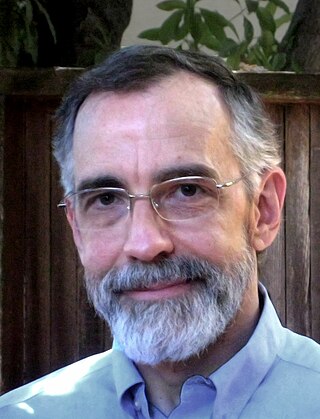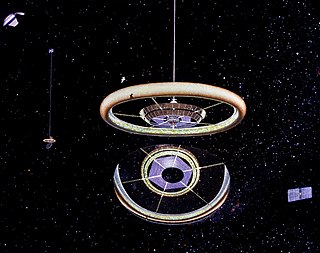
Kim Eric Drexler is an American engineer best known for studies of the potential of molecular nanotechnology (MNT), from the 1970s and 1980s. His 1991 doctoral thesis at Massachusetts Institute of Technology was revised and published as the book Nanosystems: Molecular Machinery Manufacturing and Computation (1992), which received the Association of American Publishers award for Best Computer Science Book of 1992.

Space colonization is the use of outer space or celestial bodies other than Earth for permanent habitation or as extraterrestrial territory.

A mass driver or electromagnetic catapult is a proposed method of non-rocket spacelaunch which would use a linear motor to accelerate and catapult payloads up to high speeds. Existing and contemplated mass drivers use coils of wire energized by electricity to make electromagnets, though a rotary mass driver has also been proposed. Sequential firing of a row of electromagnets accelerates the payload along a path. After leaving the path, the payload continues to move due to momentum.

A Bernal sphere is a type of space habitat intended as a long-term home for permanent residents, first proposed in 1929 by John Desmond Bernal.

A space habitat is a more advanced form of living quarters than a space station or habitation module, in that it is intended as a permanent settlement or green habitat rather than as a simple way-station or other specialized facility. No space habitat has been constructed yet, but many design concepts, with varying degrees of realism, have come both from engineers and from science-fiction authors.

The Stanford torus is a proposed NASA design for a space habitat capable of housing 10,000 to 140,000 permanent residents.

Mining the Sky: Untold Riches from the Asteroids, Comets, and Planets, is a 1997 book by University of Arizona Planetary Sciences professor emeritus John S. Lewis that describes possible routes for accessing extraterrestrial resources, either for use on Earth or for enabling space colonization. Each issue or proposal is evaluated for its effects on humanity, physics and economic feasibility based on planetary science. For instance, Chapter 5 exhaustively catalogs the types of near-Earth objects, assessing both the harms likely from possible collisions with Earth on the one hand, and their potential for profitable exploitation on the other.

Gerard Kitchen O'Neill was an American physicist and space activist. As a faculty member of Princeton University, he invented a device called the particle storage ring for high-energy physics experiments. Later, he invented a magnetic launcher called the mass driver. In the 1970s, he developed a plan to build human settlements in outer space, including a space habitat design known as the O'Neill cylinder. He founded the Space Studies Institute, an organization devoted to funding research into space manufacturing and colonization.
John S. Lewis is a Professor Emeritus of planetary science at the University of Arizona’s Lunar and Planetary Laboratory. His interests in the chemistry and formation of the Solar System and the economic development of space have made him a leading proponent of turning potentially hazardous near-Earth objects into attractive space resources.

Asteroid mining is the hypothetical extraction of materials from asteroids and other minor planets, including near-Earth objects.

Space manufacturing is the production of tangible goods beyond Earth. Since most production capabilities are limited to low Earth orbit, the term in-orbit manufacturing is also frequently used.
The L5 Society was founded in 1975 by Carolyn Meinel and Keith Henson to promote the space colony ideas of Gerard K. O'Neill.
Henry Herbert Kolm was an American physicist associated with Massachusetts Institute of Technology (MIT) for many years, with extensive expertise in high-power magnets and strong magnetic fields.
Constructed in 1976 and 1977, Mass Driver 1 was an early demonstration of the concept of the mass driver, a form of electromagnetic launcher, which in principle could also be configured as a rocket motor, using asteroidal materials for reaction mass and energized by solar or other electric power.

Brian Todd O'Leary was an American scientist, author, and NASA astronaut. He was part of NASA Astronaut Group 6, a group of scientist-astronauts chosen with the intention of training for the Apollo Applications Program.

Space-based solar power is the concept of collecting solar power in outer space with solar power satellites (SPS) and distributing it to Earth. Its advantages include a higher collection of energy due to the lack of reflection and absorption by the atmosphere, the possibility of very little night, and a better ability to orient to face the sun. Space-based solar power systems convert sunlight to some other form of energy which can be transmitted through the atmosphere to receivers on the Earth's surface.

The High Frontier: Human Colonies in Space is a 1976 book by Gerard K. O'Neill, a road map for what the United States might do in outer space after the Apollo program, the drive to place a human on the Moon and beyond. It envisions large human occupied habitats in the Earth-Moon system, especially near stable Lagrangian points. Three designs are proposed: Island one, Island two, and Island 3. These would be constructed using raw materials from the lunar surface launched into space using a mass driver and from near-Earth asteroids. The habitats were to spin for simulated gravity and be illuminated and powered by the Sun. Solar power satellites were proposed as a possible industry to support the habitats.

Lagrange point colonization is a proposed form of space colonization of the five equilibrium points in the orbit of a planet or its primary moon, called Lagrange points.

2081: A Hopeful View of the Human Future is a 1981 book by Princeton physicist Gerard K. O'Neill. The book is an attempt to predict the social and technological state of humanity 100 years in the future. O'Neill's positive attitude towards both technology and human potential distinguished this book from gloomy predictions of a Malthusian catastrophe by contemporary scientists. Paul R. Ehrlich wrote in 1968 in The Population Bomb, "in the 1970s and 1980s hundreds of millions of people will starve to death". The Club of Rome's 1972 Limits to Growth predicted a catastrophic end to the Industrial Revolution within 100 years from resource exhaustion and pollution.

An O'Neill cylinder is a space settlement concept proposed by American physicist Gerard K. O'Neill in his 1976 book The High Frontier: Human Colonies in Space. O'Neill proposed the colonization of space for the 21st century, using materials extracted from the Moon and later from asteroids.














